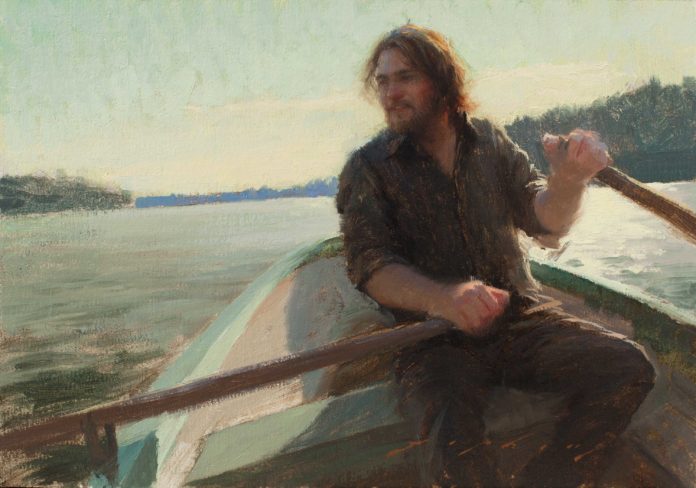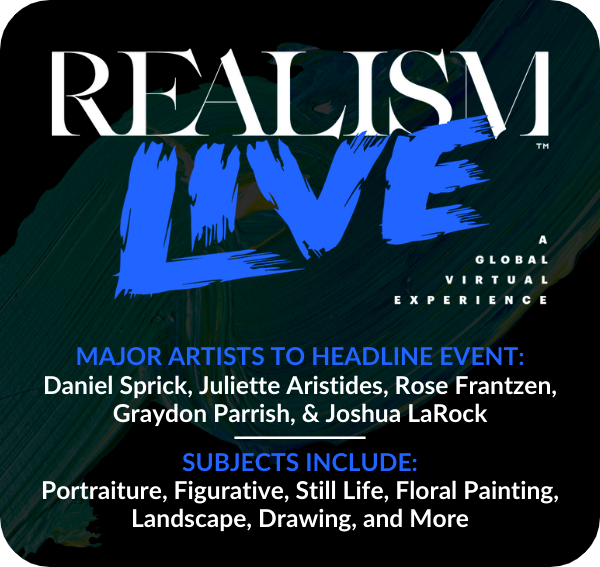
The figurative art of Jeremy Lipking > “Only rarely does an artist come along who not only can see the sensitive nuances of beauty in the world around us but who also has the skill to translate that vision onto canvas.”
By Vanessa Françoise Rothe
Jeremy Lipking (b. 1975) is widely regarded as one of the top American painters working today, creating images of figures in landscapes that are simultaneously ethereal, sincere, and truly humanist. In view of his realist subjects and disarmingly “natural” style, it makes sense that he is often cited as a key inheritor of John Singer Sargent and Anders Zorn.
Arriving at this level of mastery has required countless hours of study, practice, and work — all the more remarkable considering that Lipking is only 41 and a devoted family man: he lives in Calabasas, California, with his wife and muse, Danielle, and their children Skylar, Jacob, Sierra, and twins Juniper and Zion, who arrived just this past September.

As the son of a well-known illustrator, Ronald Lipking, Jeremy grew up in Los Angeles’s lively artistic community and spent many hours watching his father work. Early on, however, the boy was singled out for his talent in guitar playing, not drawing or painting. To this day he can pick up virtually any stringed instrument and perform a song as if he had studied it recently. This “ear” and profound openness to all the senses have surely contributed to the complexity of Lipking’s visual figurative art.
Figurative Art: Rooted in Nature
This heightened sensibility pervaded everything that Lipking saw and felt as a youngster. He recalls fondly the many summers his family spent in the Eastern Sierra, where he watched his father paint outdoors in the mountains. He, too, would spend all day outside, splashing in streams, climbing granite outcroppings, and fishing, always observing the way roots grow, the veins and shapes of leaves, the flow of rivers, and the colorful reflections on watery surfaces.
Lipking says he now realizes that “all of these experiences had a profound effect on my admiration of nature, and also gave me a perspective on life that I might not have had growing up only in an urban environment.” In adulthood, he has learned still more about the Sierras and the other unspoiled regions he paints: “When you realize you are standing in the glacier’s path, when you see landscape in geological terms, your understanding becomes so much deeper, transcending aesthetic beauty alone.”
Related Article > Daniel Graves: Making the Past Present

Indeed, before he turned to figurative art, Lipking painted only landscapes, usually in watercolors, a medium easy to carry on hiking trips. During these adventures, he made many studies, living close enough to nature to capture it in a completely natural way, with a detail-oriented attentiveness that remains in his art today.
Though he did not complete a single art class in high school, Lipking was aware (through his father) that he might hope to earn a good living as a professional artist, so he enrolled in 1997 at the California Art Institute in Westlake Village. He notes, however, that what really honed his artistic skills and vision were the more intensive encounters he enjoyed with older practitioners — for example, the drawing classes he took with the illustrators Glen Orbik and Norm Nason, and the critiques offered by such masters as David A. Leffel and Max Turner.
Over and over, Lipking read the painter Richard Schmid’s revered book, Alla Prima, which taught him about values and edges. (The two men have since painted side by side several times.) Lipking was also powerfully inspired by his father’s collection of paintings by such Western masters as Frederic Remington and the Taos Society of Artists.
Early Days
Around 2004, Lipking found himself working in a studio with slightly chipped walls painted bright blue: “There I painted a couple of nudes in sheer translucent fabrics, and I really liked the way they looked against this particular blue,” he recalls.
These were the first pictures to put Lipking on the art world map, further encouraging him to read books about, and visit museum collections of, such 19th-century French masters as William Bouguereau and Émile Friant in hopes of attaining their delicate balance of values, edges, and color. He was particularly inspired by Prof. Gabriel Weisberg’s book Beyond Impressionism: The Naturalist Impulse (1992), which introduced him to many naturalist painters, and by Dean A. Porter’s Taos Artists and Their Patrons, 1898–1950 (1999).
At age 25, just one year into his professional career, Lipking won the top prize at the California Art Club’s 2001 annual exhibition with his painting “Shady Grove,” stimulating even louder accolades nationwide. Soon afterward, New York City’s Arcadia Gallery began mounting a series of sold-out solo shows, rapidly building a truly national awareness of Lipking’s gifts. (Arcadia has since relocated to Southern California and continues to represent Lipking.)
Figurative Art in Natural Settings
So what was it that the judges and the gallery admired so much? Beyond the beauty of Lipking’s female figures and of their natural settings, surely it was their palpability — so detailed they could almost be photographic, yet captured far more ethereally than any camera could. Indeed, Lipking addresses various areas of his image in a looser, more suggestive way, with visible strokes and soft blended edges that impart a convincing naturalness.
It is this delicate balance that distinguishes his work from harder-edged contemporary realism, deftly mimicking how the human eye actually sees the world; the main subject is in focus and its surroundings slightly blurred — essentially a combination of realism and impressionism.

In the painting “Adrift,” Lipking tenderly depicts his daughter floating in a stream — a powerful and thought-provoking motif stretching back to John Everett Millais’s famous “Ophelia” (1851–52, Tate, London). Here he orchestrates a well-drawn figure, soft blended edges, and subtle changes in color, lights, and darks. Particularly masterful are the illusion of transparent water and the faint suggestion of submerged leaves.
Always Looking
Always seeking new inspirations, Lipking has in recent years traveled through America’s deserts and plains, to France and Switzerland, and also to Sweden, where he painted the same woodlands and lakes that Zorn revered. During these voyages, he particularly enjoys studying masterworks in local museums, and has paid special attention to Bouguereau, who inspires him to emulate that master’s astonishingly smooth skin and finely blended strokes.
Exciting new locales, with their differing light qualities, tree species, and textures, have also made their way into Lipking’s art. These settings range from Alpine peaks to weathered 18th-century workshops, from the blue lakes of Sweden to the brilliantly colored Mojave Desert: clearly, landscapes still play a major role in Lipking’s artistry.

Lipking confides that his work “is about the moment I experienced: the warm light that caught my eye at the end of the day fading from a mountaintop contrasting with cool shadows, the composition of the silhouette of a figure sailing on a lake with a reflection that mirrors the vessel’s dark shape, the dappled light pouring through trees onto green grass, or onto a woman’s skin.” He says, “The painting is complete when I feel I’ve captured that special aspect that I saw, or felt, in that instant.”
During regular visits to southern Utah over the past few years, Lipking has explored its warmer, brighter colors, which offer him a range of fresh subjects and combinations. He has also been exhibiting more scenes set in California landscapes, particularly in thriving Western venues such as Los Angeles’s Autry Museum of the American West and Oklahoma City’s National Cowboy & Western Heritage Museum. (He won top honors in the latter’s Prix de West competition in both 2014 and 2016.) Yet another pull in this direction is Lipking’s own ancestry: he is an enrolled member of the Keweenaw Bay Indian Community of the Lake Superior Band of Chippewa.

Although he is from California, Lipking makes art that cannot be categorized as Western, or even American, given the geographical breadth of his subject matter and the cosmopolitanism of his manner. Recently, a portrait commission from an important family brought him to France’s Loire Valley, where he was later inspired to create “Loire Valley Wood Carver.”
Only rarely does an artist come along who not only can see the sensitive nuances of beauty in the world around us but who also has the skill to translate that vision onto canvas.
To view more Jeremy Lipking paintings, visit lipking.com.
Article reprinted with permission from Fine Art Connoisseur magazine
Register for Realism Live, a global virtual art conference, October 2020:





